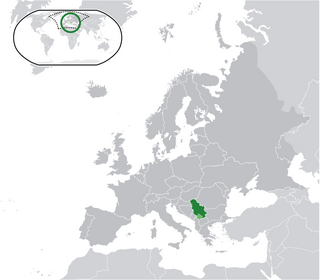Direct distance dialing (DDD) is a telecommunications service feature in North America by which a caller may, without operator assistance, call any other user outside the local calling area. Direct dialing by subscribers typically requires extra digits to be dialed as prefixes to the directory telephone number of the destination. International Direct Distance Dialing (IDDD) extends the system beyond the geographic boundaries of the North American Numbering Plan (NANP).

The North American Numbering Plan (NANP) is a telephone numbering plan for twenty-five regions in twenty countries, primarily in North America and the Caribbean. This group is historically known as World Zone 1 and has the telephone country code 1. Some North American countries, most notably Mexico, do not participate with the NANP.
A toll-free telephone number or freephone number is a telephone number that is billed for all arriving calls. For the calling party, a call to a toll-free number from a landline is free of charge. A toll-free number is identified by a dialing prefix similar to an area code. The specific service access varies by country.
A telephone numbering plan is a type of numbering scheme used in telecommunication to assign telephone numbers to subscriber telephones or other telephony endpoints. Telephone numbers are the addresses of participants in a telephone network, reachable by a system of destination code routing. Telephone numbering plans are defined in each of the administrative regions of the public switched telephone network (PSTN) and in private telephone networks.

The Australian telephone numbering plan governs the allocation of telephone numbers in Australia. It has changed many times, the most recent major reorganisation by the Australian Communications and Media Authority taking place between 1994 and 1998.

The French telephone numbering plan is used in Metropolitan France, French overseas departments and some overseas collectivities.
In telecommunications, a long-distance call (U.S.) or trunk call is a telephone call made to a location outside a defined local calling area. Long-distance calls are typically charged a higher billing rate than local calls. The term is not necessarily synonymous with placing calls to another telephone area code.
In Argentina, area codes are two, three, or four digits long. Local customer numbers are six to eight digits long. The total number of digits is ten, for example, phone number (11) 1234-5678 for Buenos Aires is made up of a 2-digit area code number and an 8-digit subscriber's number, while (383) 123-4567 would be an example of a Catamarca number.

Numbers on the Irish telephone numbering plan are regulated and assigned to operators by ComReg.

Regulation of the telephone numbers in Serbia is under the responsibility of the Regulatory Agency of Electronic Communication and Mail Services (RATEL), independent regulatory authority. The country calling code of Serbia is +381. The country has an open telephone numbering plan, with most numbers consisting of a 2- or 3-digit calling code and a 6-7 digits of customer number.
The Brazilian telephone numbering plan uses a two-digit area code plus eight-digit local phone numbers for landlines and nine digits for mobile lines. Public utility services use short phone numbers, always starting with 1.
Telephone numbers in Switzerland are defined and assigned according to the Swiss telephone numbering plan administered by the Swiss Federal Office of Communications. The plan has been changed several times and the most recent reorganization was implemented in March 2002.

The New Zealand telephone numbering plan describes the allocation of telephone numbers in New Zealand and the Pitcairn Islands.

The Spanish telephone numbering plan is the allocation of telephone numbers in Spain. It was previously regulated by the Comisión del Mercado de las Telecomunicaciones (CMT), but is now regulated by the Comisión Nacional de los Mercados y la Competencia (CNMC).

This is a discussion of telephone numbers in Ukraine. The nation of Ukraine has country code +380. It switched to the European Union's common dialing plan in 2009. Thus, Ukrainian phone numbers consist of a 2-digit zone code, an optional subzone code, an optional filler, and the local phone number. However, following the 2022 Russian invasion of Ukraine, the regions of Crimea, Donetsk, and Luhansk were given Russian telephone codes instead, as if they were following telephone numbers in Russia, by Russian authorities.

The regulation of telephone numbers in Germany is the responsibility of the Federal Network Agency of the German government. The agency has a mandate to telecommunications in Germany and other infrastructure systems..

Telephone numbers in Russia are administered by Roskomnadzor, and Ministry of Digital Development, Communications and Mass Communications of the Russian Federation. Russia's National Numbering Plan (NNP) is a four-level telephone numbering plan with local, zone, country, and international scopes, implementing a closed numbering plan, in which the number of digits of all national significant numbers (NSN) assigned to subscriber telephones is fixed at ten, with three digits for the area code, and a seven-digit subscriber number which includes a zone code of up to two digits. Internationally, Russia participates in the numbering plans of the International Telecommunication Union (ITU) provided by recommendations E.164 and E.123, using the telephone country code 7.
National conventions for writing telephone numbers vary by country. The International Telecommunication Union (ITU) publishes a recommendation entitled Notation for national and international telephone numbers, e-mail addresses and Web addresses. Recommendation E.123 specifies the format of telephone numbers assigned to telephones and similar communication endpoints in national telephone numbering plans.

Telephone numbers in Georgia consist of 9 digits and follow a closed numbering plan in which the initial 2 or 3 digits indicate the service or area code and the remaining 6 or 7 digits identify the subscriber.











